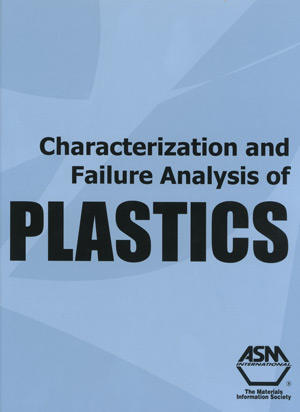Characterization and Failure Analysis of Plastics
Characterization and Failure Analysis of Plastics
Published by ASM International, Materials Park, Ohio 44073-0002 USA
ISBN: 0-87170-789-6
28.5 cm X 22.0 cm
482 pages, Illustrated, Hardbound
Retail: $184.00.

This book, as stated in the preface, is a collection of ASM Handbook articles on various characteristics of plastics. It is encyclopedic in nature and is intended for professionals in the fields of plastics engineering and plastics analysis. This book is divided into sections, each containing a series of articles pertaining to the relevant topic. The general divisions following the Introduction are “Materials Selection and Design of Engineering Plastics; Physical, Chemical, and Thermal Analysis of Plastics; Mechanical Behavior and Wear; Environmental Effects; and Failure Analysis of Plastics.”
The Introduction begins with an overview of the fundamentals of polymer chemistry. It contains the names, structures, and abbreviations of polymers, and various chemical, optical, and thermal data on selected thermoplastic and thermosetting resins. The later part of the introduction focuses on the effects that composition, processing, and structure have on the properties of plastics.
The section on design begins with end-use requirements and then provides specific information on how geometry, composition, structure, and cost are considered during the design process. Attention is given to specific processing methods, such as injection molding, extrusion, and blow molding, just to name a few. This section also emphasizes the importance of selecting materials and understanding the properties of plastics so that the proper materials and manufacturing methods are chosen.
With respect to physical, chemical, and thermal properties of plastics, a wide variety of analytical methods are presented for testing. Some of the properties that are measured include molecular weight, melting point, glass transition temperature, flammability, and conductivity. These properties are determined by measuring viscosity, by performing ignition tests, and by using techniques such as differential scanning calorimetry (DSC), thermogravimetric analysis (TGA), thermomechanical analysis (TMA), and chromatography. Optical properties, such as refractive index and birefringence are measured by various ASTM testing methods.
Additional test methods are discussed with respect to the mechanical behavior of plastics and how they are affected by stress, friction, fatigue, wear, and aging. Environmental effects, such as chemical attack and exposure to moisture, heat, light, and microorganisms are discussed in detail. Quantitative measurements for degradation and the analysis of corrosion products are also considered.
The book ends with a section on failure analysis, which provides valuable data for improving the design and manufacturing processes. The discussion on failure analysis incorporates many analytical techniques, including but not limited to x-ray diffraction (XRD), Fourier transform infrared spectroscopy (FTIR), scanning electron microscopy (SEM), Auger electron spectroscopy (AES), mass spectrometry (MS), and various thermal techniques previously mentioned. Four specific examples of failure analysis applications are provided: 1) Delamination of Polyester Insulation from Brass Cable Connectors; 2) Printed Circuit Boards; 3) Paint Delamination from a Molded Cabinet; and 4) Delamination of a Surface-Mounted Integrated Circuit (IC) from a Solder Pad.
The articles are accompanied by applicable tables, graphs, spectra, flow charts, equations, chemical structures, diagrams, photographs, and micrographs. These illustrations are relatively simple, sufficiently labeled, and easy to interpret; the tables are well organized and allow one to access reference data easily and quickly; and the micrographs, most of which occur in the sections on mechanical wear and failure analysis, are clear and informative. References are listed at the end of each article, and the final article is followed by a key for abbreviations and symbols used in the plastics industry. An index is also included.
This book is rather technical and is not to be read from cover to cover. Instead, it is to be used as a reference book or as a laboratory resource for those involved in the manufacturing of plastics and the analysis of plastics.
Comments
add comment